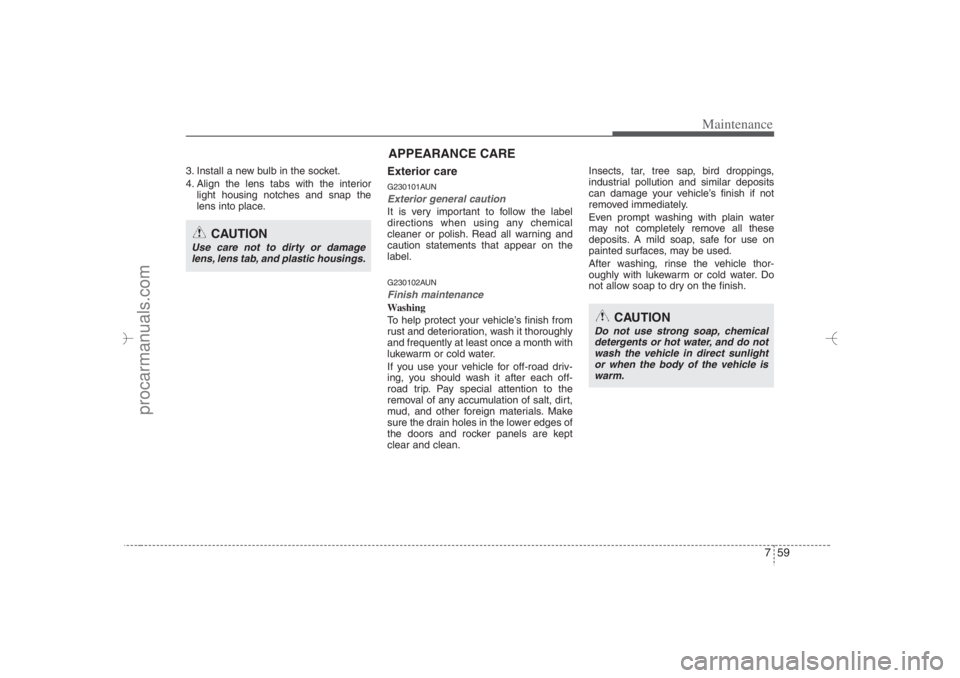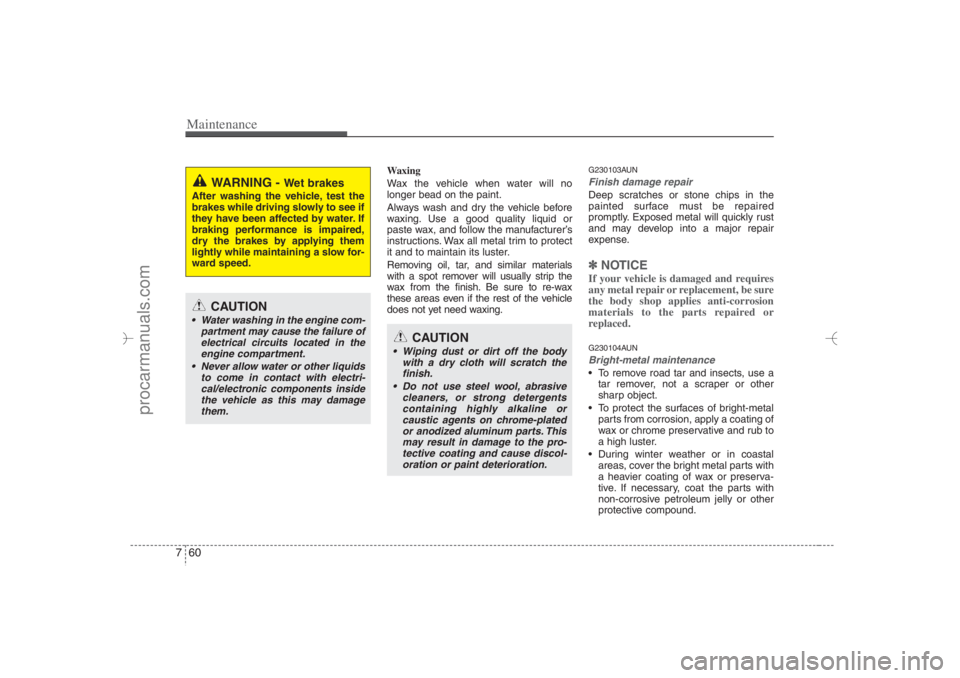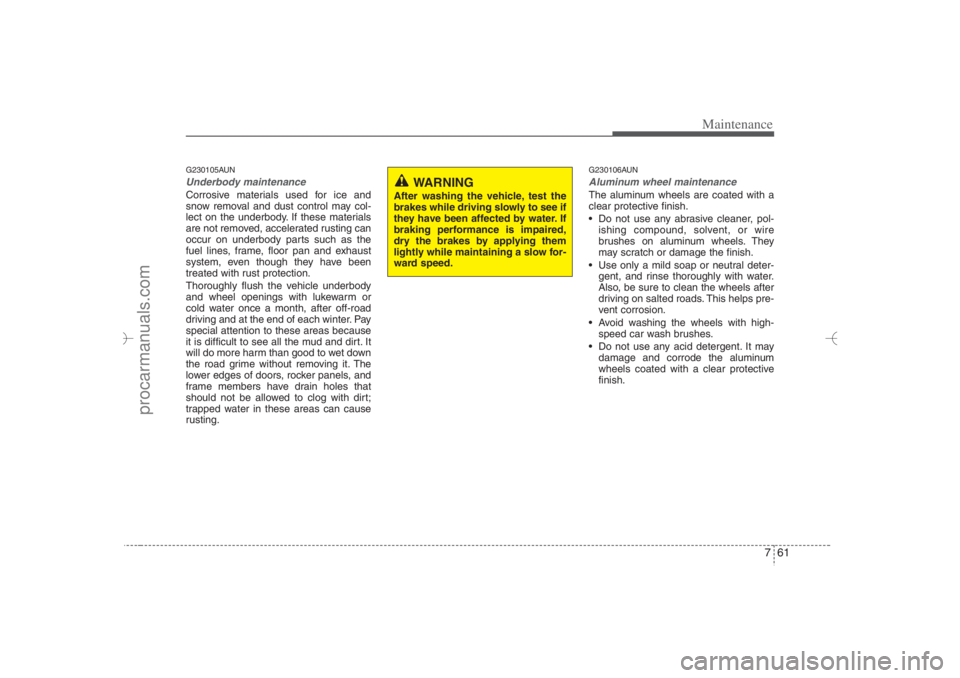2007 HYUNDAI VERACRUZ warning
[x] Cancel search: warningPage 412 of 441

Maintenance58 7
G220600AUNInterior light bulb replacement1. Using a flat-blade screwdriver, gently
pry the lens from the interior light
housing.
2. Remove the bulb by pulling it straight
out.
WARNING
Prior to working on the Interior
Lights, ensure that the “OFF” but-
ton is depressed to avoid burning
your fingers or receiving an electric
shock.
OEN076046
Map lamp (2nd row) (if equipped)
OEN076040
Map lamp (1st row)
OEN076042
OEN076044OEN076043
Luggage lampSunvisor lamp
OEN076041
Room lamp (2nd row)Room lamp (3rd row)
OEN076045
Glove box lamp
EN hma 7.qxd 11/28/2006 3:48 PM Page 58
procarmanuals.com
Page 413 of 441

759
Maintenance
3. Install a new bulb in the socket.
4. Align the lens tabs with the interior
light housing notches and snap the
lens into place.
Exterior careG230101AUNExterior general caution It is very important to follow the label
directions when using any chemical
cleaner or polish. Read all warning and
caution statements that appear on the
label.G230102AUNFinish maintenanceWashing
To help protect your vehicle’s finish from
rust and deterioration, wash it thoroughly
and frequently at least once a month with
lukewarm or cold water.
If you use your vehicle for off-road driv-
ing, you should wash it after each off-
road trip. Pay special attention to the
removal of any accumulation of salt, dirt,
mud, and other foreign materials. Make
sure the drain holes in the lower edges of
the doors and rocker panels are kept
clear and clean.Insects, tar, tree sap, bird droppings,
industrial pollution and similar deposits
can damage your vehicle’s finish if not
removed immediately.
Even prompt washing with plain water
may not completely remove all these
deposits. A mild soap, safe for use on
painted surfaces, may be used.
After washing, rinse the vehicle thor-
oughly with lukewarm or cold water. Do
not allow soap to dry on the finish.
CAUTION
Use care not to dirty or damage
lens, lens tab, and plastic housings.
APPEARANCE CARE
CAUTION
Do not use strong soap, chemical
detergents or hot water, and do not
wash the vehicle in direct sunlight
or when the body of the vehicle is
warm.
EN hma 7.qxd 11/28/2006 3:48 PM Page 59
procarmanuals.com
Page 414 of 441

Maintenance60 7
Waxing
Wax the vehicle when water will no
longer bead on the paint.
Always wash and dry the vehicle before
waxing. Use a good quality liquid or
paste wax, and follow the manufacturer’s
instructions. Wax all metal trim to protect
it and to maintain its luster.
Removing oil, tar, and similar materials
with a spot remover will usually strip the
wax from the finish. Be sure to re-wax
these areas even if the rest of the vehicle
does not yet need waxing.
G230103AUNFinish damage repair Deep scratches or stone chips in the
painted surface must be repaired
promptly. Exposed metal will quickly rust
and may develop into a major repair
expense.✽ ✽
NOTICEIf your vehicle is damaged and requires
any metal repair or replacement, be sure
the body shop applies anti-corrosion
materials to the parts repaired or
replaced. G230104AUNBright-metal maintenance To remove road tar and insects, use a
tar remover, not a scraper or other
sharp object.
To protect the surfaces of bright-metal
parts from corrosion, apply a coating of
wax or chrome preservative and rub to
a high luster.
During winter weather or in coastal
areas, cover the bright metal parts with
a heavier coating of wax or preserva-
tive. If necessary, coat the parts with
non-corrosive petroleum jelly or other
protective compound.
WARNING -
Wet brakes
After washing the vehicle, test the
brakes while driving slowly to see if
they have been affected by water. If
braking performance is impaired,
dry the brakes by applying them
lightly while maintaining a slow for-
ward speed.
CAUTION
Water washing in the engine com-
partment may cause the failure of
electrical circuits located in the
engine compartment.
Never allow water or other liquids
to come in contact with electri-
cal/electronic components inside
the vehicle as this may damage
them.
CAUTION
Wiping dust or dirt off the body
with a dry cloth will scratch the
finish.
Do not use steel wool, abrasive
cleaners, or strong detergents
containing highly alkaline or
caustic agents on chrome-plated
or anodized aluminum parts. This
may result in damage to the pro-
tective coating and cause discol-
oration or paint deterioration.
EN hma 7.qxd 11/28/2006 3:48 PM Page 60
procarmanuals.com
Page 415 of 441

761
Maintenance
G230105AUNUnderbody maintenanceCorrosive materials used for ice and
snow removal and dust control may col-
lect on the underbody. If these materials
are not removed, accelerated rusting can
occur on underbody parts such as the
fuel lines, frame, floor pan and exhaust
system, even though they have been
treated with rust protection.
Thoroughly flush the vehicle underbody
and wheel openings with lukewarm or
cold water once a month, after off-road
driving and at the end of each winter. Pay
special attention to these areas because
it is difficult to see all the mud and dirt. It
will do more harm than good to wet down
the road grime without removing it. The
lower edges of doors, rocker panels, and
frame members have drain holes that
should not be allowed to clog with dirt;
trapped water in these areas can cause
rusting.
G230106AUNAluminum wheel maintenance The aluminum wheels are coated with a
clear protective finish.
Do not use any abrasive cleaner, pol-
ishing compound, solvent, or wire
brushes on aluminum wheels. They
may scratch or damage the finish.
Use only a mild soap or neutral deter-
gent, and rinse thoroughly with water.
Also, be sure to clean the wheels after
driving on salted roads. This helps pre-
vent corrosion.
Avoid washing the wheels with high-
speed car wash brushes.
Do not use any acid detergent. It may
damage and corrode the aluminum
wheels coated with a clear protective
finish.
WARNING
After washing the vehicle, test the
brakes while driving slowly to see if
they have been affected by water. If
braking performance is impaired,
dry the brakes by applying them
lightly while maintaining a slow for-
ward speed.
EN hma 7.qxd 11/28/2006 3:48 PM Page 61
procarmanuals.com
Page 420 of 441

Maintenance66 7G270201AUNCanisterFuel vapors generated inside the fuel
tank are absorbed and stored in the
onboard canister. When the engine is
running, the fuel vapors absorbed in the
canister are drawn into the surge tank
through the purge control solenoid valve.G270202AUNPurge Control Solenoid Valve (PCSV)The purge control solenoid valve is con-
trolled by the Engine Control Module
(ECM); when the engine coolant temper-
ature is low during idling, the PCSV clos-
es so that evaporated fuel is not taken
into the engine. After the engine warms-
up during ordinary driving, the PCSV
opens to introduce evaporated fuel to the
engine.
G270300AUN3. Exhaust emission control
systemThe Exhaust Emission Control System is
a highly effective system which controls
exhaust emissions while maintaining
good vehicle performance.G270301AUNVehicle modifications This vehicle should not be modified.
Modification of your vehicle could affect
its performance, safety or durability and
may even violate governmental safety
and emissions regulations.
In addition, damage or performance
problems resulting from any modification
may not be covered under warranty.G270302AUN-EUEngine exhaust gas precautions (car-
bon monoxide) Carbon monoxide can be present with
other exhaust fumes. Therefore, if you
smell exhaust fumes of any kind inside
your vehicle, have it inspected and
repaired immediately. If you ever sus-
pect exhaust fumes are coming into
your vehicle, drive it only with all the
windows fully open. Have your vehicle
checked and repaired immediately.
WARNING
- Exhaust
Engine exhaust gases contain car-
bon monoxide (CO). Though color-
less and odorless, it is dangerous
and could be lethal if inhaled.
Follow the instructions on this
page to avoid CO poisoning.
PROPOSITION 65
WARNING
Engine exhaust and a wide variety
of automobile components and
parts, including components found
in the interior furnishings in a vehi-
cle, contain or emit chemicals
known to the State of California to
cause cancer and birth defects and
reproductive harm. In addition, cer-
tain fluids contained in vehicles
and certain products of component
wear contain or emit chemicals
known to the State of California to
cause cancer and birth defects or
other reproductive harm.
EN hma 7.qxd 11/28/2006 3:48 PM Page 66
procarmanuals.com
Page 421 of 441

767
Maintenance
Do not operate the engine in confined
or closed areas (such as garages) any
more than what is necessary to move
the vehicle in or out of the area.
When the vehicle is stopped in an
open area for more than a short time
with the engine running, adjust the
ventilation system (as needed) to draw
outside air into the vehicle.
Never sit in a parked or stopped vehi-
cle for any extended time with the
engine running.
When the engine stalls or fails to start,
excessive attempts to restart the
engine may cause damage to the
emission control system.
G270303AENOperating precautions for catalytic
converters Your vehicle is equipped with a catalytic
converter emission control device.
Therefore, the following precautions
must be observed:
Use only UNLEADED FUEL for gaso-
line engines.
Do not operate the vehicle when there
are signs of engine malfunction, such
as misfire or a noticeable loss of per-
formance. Do not misuse or abuse the engine.
Examples of misuse are coasting with
the ignition off and descending steep
grades in gear with the ignition off.
Do not operate the engine at high idle
speed for extended periods (5 minutes
or more).
Do not modify or tamper with any part
of the engine or emission control sys-
tem. All inspections and adjustments
must be made by an authorized
HYUNDAI dealer.
Avoid driving with a very low fuel level.
If you run out of gasoline, it could
cause the engine to misfire and result
in excessive loading of the catalytic
converter.
Failure to observe these precautions
could result in damage to the catalytic
converter and to your vehicle.
Additionally, such actions could void your
warranties.
WARNING
- Fire
A hot exhaust system can ignite
flammable items under your vehi-
cle. Do not park the vehicle over or
near flammable objects, such as
grass, vegetation, paper, leaves,
etc.
EN hma 7.qxd 11/28/2006 3:48 PM Page 67
procarmanuals.com
Page 434 of 441

Index2I
Air bags-advanced supplemental restraint system ········3-37
Air bag warning label ··················································3-62
Air bag warning light ··················································3-40
Curtain air bag ·····························································3-54
Driver's and passenger's front air bag ·························3-48
Occupant classification system ···································3-43
Side impact air bag ······················································3-52
Air cleaner ·····································································7-21
All wheel drive (AWD) ·················································5-14
Appearance care·····························································7-59
Exterior care ································································7-59
Interior care ·································································7-64
Audio system ·······························································4-121
Antenna······································································4-121
M445/M446 ·······························································4-126
M466··········································································4-142
M466 RSE ·································································4-154
Steering wheel audio control ·····································4-121
Automatic climate control system ·································4-96
Air conditioning ························································4-102
Automatic heating and air conditioning ······················4-97
Manual heating and air conditioning···························4-98
Rear heating and air conditioning ·····························4-103
Automatic transaxle ·························································5-8
Ignition key interlock system ······································5-12
Shift lock system ·························································5-12
Sports mode ·································································5-11Battery············································································7-27
Before driving ··································································5-3
Brake system··································································5-21
Anti-lock brake system (ABS) ····································5-24
Electronic stability control (ESC) ·······························5-26
Parking brake ·······························································5-22
Power brakes ·······························································5-21
Brakes fluid····································································7-18
Bulb wattage ····································································9-2
California Perchlorate Notice ······································· 7-68
Child restraint system ····················································3-29
Placing a passenger seat belt into
the auto lock mode ···················································3-32
Securing a child restraint seat with
tether anchor system·················································3-34
Securing a child restraint seat with
child seat lower anchor system ································3-35
Climate control air filter ················································7-22
Consumer information ·····················································8-4
Cruise control system ····················································5-31
Defroster ········································································4-83
Dimensions ······································································9-2
Door locks······································································4-15A
BCD
EN hma Index.qxd 11/28/2006 1:23 PM Page 2
procarmanuals.com
Page 435 of 441

I3
Index
Central door lock switch ·············································4-16
Child-protector rear door lock ·····································4-18
Driver position memory system ····································4-38
Economical operation ····················································5-35
Emergency starting ··························································6-4
Jump starting ·································································6-4
Push starting ··································································6-5
Emission control system ················································7-65
Crankcase emission control system·····························7-65
Evaporative emission control (including ORVR:
Onboard Refueling Vapor Recovery) System ·············7-65
Exhaust emission control system ································7-66
Engine compartment ················································2-4, 7-2
Engine coolant ·······························································7-15
Engine number ·································································8-3
Engine oil ·······································································7-14
Explanation of scheduled maintenance items················7-11
Exterior features···························································4-119
Roof rack ···································································4-119
Fuel filler lid ··································································4-31
Emergency fuel filer lid release ··································4-33
Fuel requirements ····························································1-3
Fuses ··············································································7-43
Fuse/relay panel description ········································7-47Main fuse ·····································································7-46
Memory fuse································································7-45
Hazard warning flasher··················································4-71
Hood···············································································4-30
How to use this manual ···················································1-2
If the engine overheats·····················································6-6
If the engine will not start ···············································6-3
If you have a flat tire ·····················································6-12
Changing tires······························································6-14
Compact spare tire ·······················································6-19
Jack and tools ······························································6-12
Removing and storing the spare tire ···························6-13
In case of an emergency while driving····························6-2
Indicator symbols on the instrument cluster ···················1-7
Instrument cluster ··························································4-52
Engine temperature gauge ···········································4-54
Fuel gauge ···································································4-55
Instrument panel illumination ·····································4-53
Odometer/Tripmeter ····················································4-55
Speedometer ································································4-53
Tachometer ··································································4-53
Trip computer ······························································4-56
Warning and indicators ················································4-59
Instrument panel overview ··············································2-3EF
HI
EN hma Index.qxd 11/28/2006 1:23 PM Page 3
procarmanuals.com